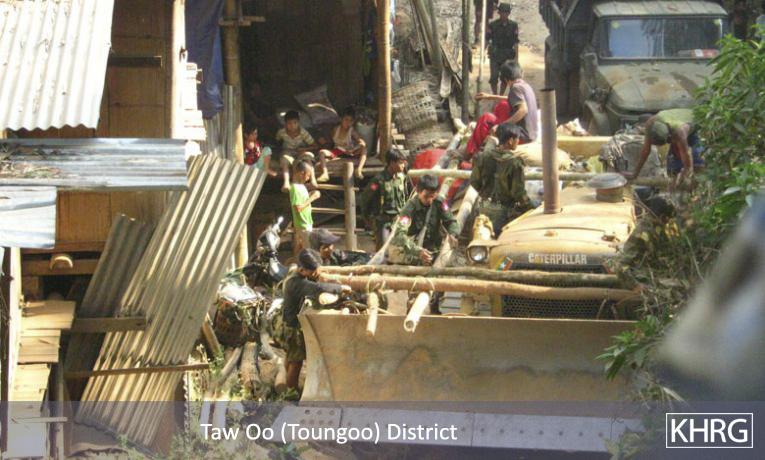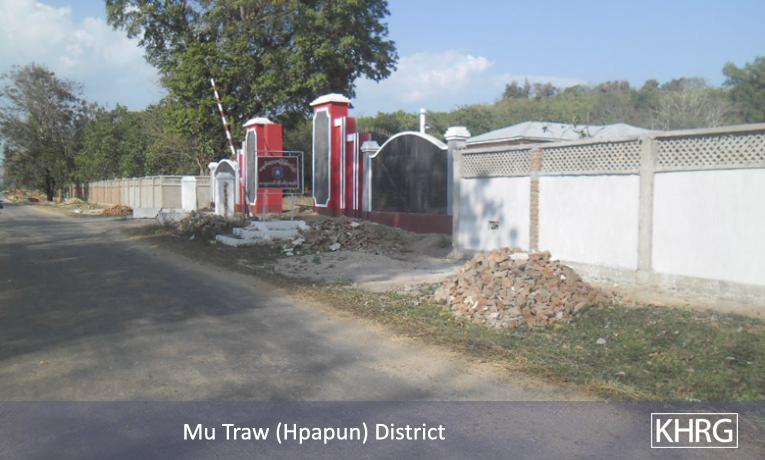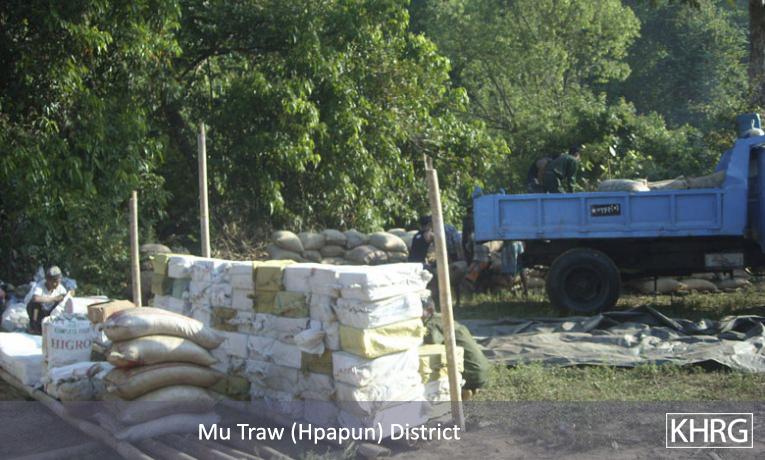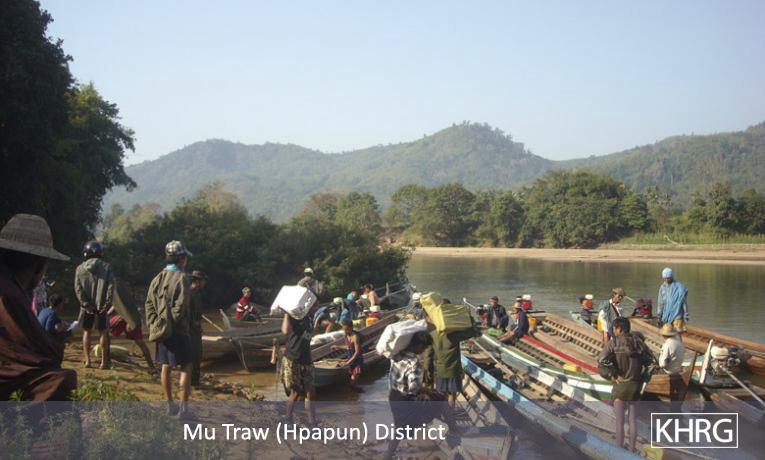This News Bulletin describes the ongoing militarisation of southeastern Burma/Myanmar by the Burma/Myanmar Tatmadaw and Border Guard Force (BGF) following the January 2012 ceasefire between the government of Burma/Myanmar and the Karen National Union (KNU). Villagers in mixed control areas throughout this region have raised concerns that the ceasefire will break down and fighting will begin again, after observing the activities of the Burma/Myanmar Tatmadaw army.[1]
Following the January 2012 ceasefire,[2] villagers have consistently reported to KHRG that Burma/Myanmar Tatmadaw soldiers have moved with greater ease and frequency throughout KHRG’s research areas in southeastern Burma/Myanmar, causing feelings of insecurity and anxiety among villagers. KHRG has received information regarding various aspects of ongoing militarisation, including the Tatmadaw repairing and constructing roads for military use, resupplying their camps with ammunition and food, and strengthening and repairing camps in Toungoo, Nyaunglebin, Hpapun and Dooplaya districts in southeastern Burma/Myanmar.
Toungoo District
In December 2013, Tatmadaw soldiers in Toungoo District transported a large amount of rations and ammunition using civilian roads. According to the villagers in the area, the Tatmadaw assigned 100 of their soldiers to provide security for the convoy, and they used more than a hundred horses for transporting the supplies. Villagers also reported that when the Tatmadaw are transporting rations and ammunition, despite the fact that the ceasefire is in place and that they are not disturbed by the Karen National Liberation Army (KNLA), they continue to fire mortars in civilian areas to deter KNLA ambushes. As a result, villagers in Toungoo District are worried that fighting will resume again. The Tatmadaw, although they have signed the ceasefire, are transporting rations and ammunition in greater numbers than are needed, according to local civilians.[3]
Nyaunglebin District
In Nyaunglebin District, the Tatmadaw sent more rations than is typical to their frontline army camps, beginning in early 2014. In past years, such as 2013, they would resupply their camps with rations using 40 trucks, or 50 trucks at the most, in one day. In 2014, villagers have reported between 60 and 70 trucks being used to transport their rations. Additionally, in 2014 this process took them three or four days, while in past years, they were able to transport their rations and return within one day. The rations the trucks transported were not for the villagers and the villagers do not know exactly where they are sending the supplies. Before the ceasefire, the villagers had to porter the rations for the Tatmadaw soldiers but presently they use a lot of trucks to transport them instead.[4] This activity by the Tatmadaw has increased feelings of insecurity among local villagers.
Hpapun District
In Hpapun District, in areas populated by internally displaced persons (IDPs), villagers have reported that the Tatmadaw has repaired a vehicle road, and they also have created a new vehicle track, which they built one cubit[5] deep, due to fears that the KNLA might plant landmines on the road where they patrol and send rations. By constructing the track this way, if the KNLA planted landmines, the Tatmadaw would see them. They have also repaired and improved the trenches and fencing surrounding their camps. Additionally, the Tatmadaw fired heavy weapons during the times when they were transporting their rations and ammunition, to deter KNLA ambushes, the same tactic as that used in Toungoo District. Thus, the villagers are afraid and worried that there will be a resumption in fighting, despite the ceasefire.[6]
In Bu Tho Township, Hpapun District, villagers reported that while they had seen a reduction in Tatmadaw patrolling and other activities, they have experienced an increased presence of two Border Guard Force (BGF)[7] battalions (#1013 and #1014), who have been active in the area since the ceasefire. Villagers in Bu Tho Township have raised numerous concerns regarding the BGF’s soldiers and officers from these two battalions, as they have committed multiple human rights violations, including the violent abuse of villagers, as well as threatening, demanding taxation and forced labour.[8]
Dooplaya District
In Dooplaya District, a villager reported:
"The ethnic groups [Tatmadaw and KNU] are in a ceasefire. If we look at the [current] situation, although they [Tatmadaw] said they have stopped fighting, we do not know what they have planned. They also have not withdrawn the Border Guard Force (BGF) soldiers. They [Tatmadaw] are [still] sending rations and weapons [to their camps]. We do not know what their purpose [for doing this] is. If we look at the [Thai-Burma/Myanmar] border in Kwee Ler Ter, Per Hkler and Tha Waw Thaw villages, the Tatmadaw repair their camps to be better. It is not good for the villagers [as they might harm the villagers]. It is not a good thing."[9]
Conclusion
Overall, based on KHRG reporting since the 2012 preliminary ceasefire, villagers in southeastern Burma/Myanmar have experienced a reduced number of human rights violations committed by armed groups. However, when villagers see the increase in Tatmadaw military activities in the region, it increases feelings of insecurity, and makes them fear that fighting will reoccur.
This photo was taken by a KHRG community member on October 8th 2013 in Thaundaunggyi Town, Toungoo District. This photo shows troops from the Tatmadaw Southern Command headquarters transporting rations with 20 trucks straight to Taw Poh camp where Light Infantry Battalion (LIB) #930 is based. The villagers who live in that area were surprised and concerned about what might happen next, because they felt that the Tatmadaw were transporting more rations then they need. [Photo: KHRG]
These photos were taken by a KHRG community member on March 21st 2013 in Htantabin Township, Toungoo District. These are photos of Light Infantry Division (LID) #66 coming to Buh Hsa Hkee army camp. According to a KHRG community member, LID #66 sent a lot of food to the area. As pictured, LID #66 sent not only food, but also two bulldozers to use for military purposes. [Photos: KHRG]
The first photo was taken by a KHRG community member in November 2013 and shows the Tatmadaw transporting horses to the frontlines with a truck. The second photo was taken in December 2013 and illustrates how the Tatmadaw would send rations with horses in Thandaunggyi Township, Toungoo District. [Photos: KHRG]
This photo was taken by a KHRG community member in November 2013 in Bu Tho Township, Hpapun District. This photo shows Tatmadaw Light Infantry Battalion (LIB) #434’s army base, situated in between Way Hsah and T’Koh Teh villages. According to the KHRG community member, this army base was originally fenced with bamboo and barbed-wire, but in the beginning of 2013, the camp was strengthened and fenced with bricks and cement. [Photo: KHRG]
These photos were taken by a KHRG community member on January 13th 2014, in Dwe Lo Township, Hpapun District. These are photos of boats that transport rice sacks and other things for the Tatmadaw. They are a full years rations for the Burmese soldiers to consume in 2014; they asked the villagers to transport the rations, in exchange for pay. Light Infantry Battalion (LIB) #555 was based in Meh Pre Hkee camp and Hkoo Thoo Hta camp from 2013 to 2014 and Infantry Battalion (IB) #96 is based in Waw Mu camp, Kay Kaw camp and Meh Way camp. Forced labour, arbitrary taxation and asking for porters by the Tatmadaw have reduced significantly. The Tatmadaw soldiers who live in Wah Mu camp, Kay Kaw camp, Meh Way camp and Hku Thu Hta asked the village heads to arrange the boats pictured to transport their rations, which will supply them for a year. The villagers who have boats did it. The Tatmadaw soldiers provided fuel and boat propellers for the villagers who participated, and the villagers were very happy. Some boat owners said that the Tatmadaw soldiers were becoming more and more friendly. In the past, the Tatmadaw forced the villagers to transport things and the villagers were very fearful of them. Cases of forced labour and arbitrary taxation have reduced following the ceasefire and the villagers view this as a positive development. [Photos: KHRG]
Footnotes:
[1] This News Bulletin was written by KHRG office staff and is based on information from community members throughout KHRG’s research areas who have been trained by KHRG to monitor local human rights conditions. In order to increase the transparency of KHRG methodology and more directly communicate the experiences and perspectives of villagers in eastern Burma/Myanmar, KHRG aims to make all field information received available on the KHRG website once it has been processed and translated, subject only to security considerations. For additional reports categorised by Type, Issue, Location and Year, please see the Related Readings component following each report on KHRG’s Website.
[2] On January 12th 2012, a preliminary ceasefire agreement was signed between the KNU and Burma/Myanmar government in Hpa-an. Negotiations for a longer-term peace plan are still under way. For updates on the peace process, see the KNU Stakeholder webpage on the Myanmar Peace Monitor website. For KHRG's analysis of changes in human rights conditions since the ceasefire, see Truce or Transition? Trends in human rights abuse and local response since the 2012 ceasefire, KHRG, May 2014.
[3] For further information, please see the KHRG report “Toungoo Incident Report: Tatmadaw transport rations and ammunition in Thandaunggyi Township, December 2013,” KHRG, October 2014.
[4] For further information, please see the KHRG report “Nyaunglebin Situation Update: Kyaukkyi Township, July 2014,” KHRG, October 2014.
[5] A cubit is a standard measurement for the length of bamboo poles, commonly referred to in Karen as the length from one’s fingertips to one’s elbow, about 45.7 cm. or 18 in.
[6] For further information, please see the KHRG report “Hpapun Incident Report: Tatmadaw’s mortar shelling and military activities in Lu Thaw Township, December 2013,” KHRG, June 2014. Additional information came from an unpublished Situation Update and an unpublished Incident Report from KHRG researchers in Hpapun District.
[7] Border Guard Force (BGF) battalions of the Tatmadaw were established in 2010, and they are composed mostly of soldiers from former non-state armed groups, such as older constellations of the DKBA, which have formalised ceasefire agreements with the Burmese government and agreed to transform into battalions within the Tatmadaw. BGF battalions are assigned four digit battalion numbers, whereas regular Tatmadaw infantry battalions are assigned two digit battalion numbers and light infantry battalions are identified by two or three-digit battalion numbers. For more information, see “DKBA officially becomes Border Guard Force” Democratic Voice of Burma, August 2010, and, “Exploitation and recruitment under the DKBA in Pa’an District,” KHRG, June 2009.
[8] KHRG has documented numerous abuses committed by these two battalions, and in particular by 2nd Lieutenant Saw Tha Beh of BGF Battalion #1014. For further details on officer Tha Beh, please see the previously published News Bulletin “Violent abuse and forced labour in Hpapun District, November 2013 – January 2014,” KHRG, September 2014 and “Hpapun Situation Update: Bu Tho Township, November 2013 to February 2014,” KHRG, September 2014.
[9] For further information, please see “Dooplaya Situation Update: Kyainseikgyi, Kawkareik and Win Yay townships, December 2013 to February 2014,” KHRG, September 2014.


















